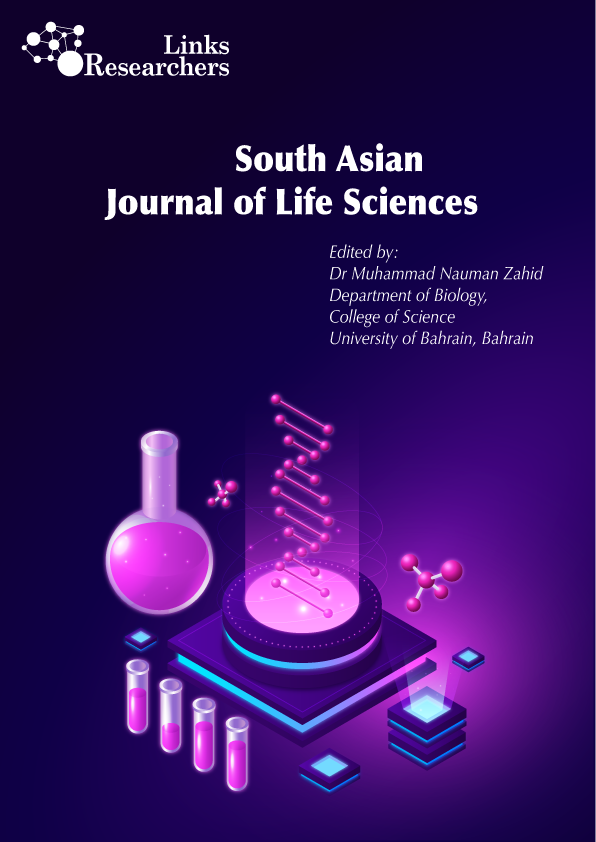South Asian Journal of Life Sciences
Mini Review
A Brief Review of Chemical Analysis of Syzygium aromaticum Essential Oil and its Antimicrobial Efficacy against Bacterial and Fungal Pathogens
Rana Haider Ali1*, Suleman Irfan1, H.M. Usman Siddiq1, Sami Ullah1, Hakeem Ullah2, Toqeer Ahmed1
1Department of Microbiology, University of Veterinary and Animal Sciences, Lahore, Pakistan; 2Department of Parasitology, University of Veterinary and Animal Sciences, Lahore, Pakistan.
Abstract | Numerous pathogenic fungi and bacteria have been described for causing various cases of illness, diseases, and various disorders which have been of significant concern to public health. Commercial antimicrobial medications have been used for fighting infectious diseases for past few decades but there are many disadvantages concerning indiscriminate use of antimicrobial medications including antimicrobial resistance, need for long term therapy, comparatively more cost and failure in treatment. So, there is growing efforts in discovery of safer and alternative means to lessen microbial growth. Plants derived natural products are immense source of therapeutic medications for treating various ailments, acting as potential substitutes to antibiotics against the infectious diseases. Plant essential oils have been known for many decades for their biological actions and are extensively used for various functions such as antibacterial, antiviral, antifungal and insecticidal. Antimicrobial activities of plant essential oil results in screening of a widespread range of plant species and their exclusive biologically active compounds. Mostly essential oils contain the chemical components such as class of terpenoid having sequiterpenes, monoterpenes, and their oxygenated derivatives. This review article focuses on the antimicrobial efficacy of clove essential oil against bacterial and fungal pathogens of public health significance followed by concise review of its chemical analysis.
Keywords: Syzygium aromaticum, Essential oil, Antimicrobial efficacy, Chemical analysis, Pathogens
Received | June 22, 2020 Accepted | July 15, 2020; Published | August 05, 2020
*Correspondence | Rana Haider Ali, Department of Microbiology, University of Veterinary and Animal Sciences, Lahore, Pakistan; Email: ranahaiderali94@gmail.com
Citation | Ali RH, Irfan S, Siddiq HMU, Ullah S, Ullah H, Ahmed T (2020). A brief review of chemical analysis of syzygium aromaticum essential oil and its antimicrobial efficacy against bacterial and fungal pathogens S. Asian J. Life Sci. 8(2): 38-41.
DOI | http://dx.doi.org/10.17582/journal.sajls/2020/8.2.38.41
ISSN | 2311–0589
Copyright © 2020 Ali et al. This is an open access article distributed under the Creative Commons Attribution License, which permits unrestricted use, distribution, and reproduction in any medium, provided the original work is properly cited.
Introduction
Medicinal plants have been used as source of therapeutic medications for the treatment of various ailments since long time. Infectious diseases are responsible for various health problems in developing countries (Bansod & Rai, 2008). The highest prevalent cause of clinical infections around the globe is Staphylococcus aureus, since it was first pathogen proposed to be a cause of the wound infection (Ogston, 1882) causing surgical wound infections, bacteremia, superficial skin infections and toxic shock syndrome (Holden et al., 2004). Commercial antimicrobial medications have been used for the past few decades for fighting infectious diseases but extended use of these antibiotics have lead to the development of resistance and other adverse effects (Fu et al., 2007). The World Health Organization has declared the multi drug resistance as a global challenge and has mentioned all the main antibiobic resistant bacteria consisting of S. aureus, Streptococcus pneumonia, Salmonella typhi, Vibrio cholera Shigella dysenteriae, and Mycobacterium tuberculosis (Tenover, 2001). S. aureus has developed considerable public attention all over the world due to growing mortality rate linked with the multi drug resistance (Waters et al., 2011). In the past few decades, Methicillin Resistant Staphylococcus aureus has showed increased resistance not only to methicillin but also to a wide range of other antibiotics including gentamycin, erythromycin, tetracycline and vancomycin (Tenover, 2006).
Cloves are dried flower buds of Syzgium aromaticum or Eugenia caryophyllata, which belongs to family Myrtaceae. These buds are utilized as ground or whole cloves and then added in desserts, pickling, drinks, and cooking. Essential oil of S. aromaticum has important biological actions, such as antibacterial, antiviral, antifungal, and insecticidal characteristics (Sanla-Ead et al., 2006). Biological action of S. aromaticum essential oil is due to some bio active components, which acts as an alternative to the traditional antibiotics. They are the phytochemicals (Ali et al., 2009). It is active against bacteria linked with oral cavity, triggering periodontal disease and also dynamic against several other enteric and pathogenic bacteria (Chaieb et al., 2007).
Antimicrobial Activities of Syzygium aromaticum Essential Oil
Various spices usually used for the chemotherapy were tested for their antimicrobial activity against pathogenic bacteria and yeast. Among them garlic and cloved produced better antimicrobial action, able to control main pathogens including Staphylococcous epidermidis and Salmonella typhi with three hours and yeast within an hour. On the foundation of results (Arora and Kaur, 1999) recommended that garlic and clove for their potential antimicrobial action. Major bacterial and fungal species responsible for the food spoilage were tested for their sensitivity against mixture of cinnamon and clove oils. Anaerobic conditions were given to pathogens when tested for the antimicrobial action. Aspergillus flavus and Eurotium were found to be only resistant when 1:1 ratio was used. However, it also showed susceptibility at more concentration of clove and cinnamon oil (Matan et al., 2006). Antimycotic activity of clove, thyme and summer savory were tested against A. flavus using tomato paste and culture media. Paste and broth were kept for two months after adding A. flavus and different concentrations of essential oils. All the essential oils manifested inhibitory effects at varying concentrations both on the tomato paste and culture media (Omidbeygi et al., 2007). In a study the antibacterial action of essential oils, infusion and decoction of clove against Gram negative bacilli by applying the disc diffusion method was performed. Aqueous infusion and decoction produced most activity against Pseudomonas aeruginaosa while essential oil was found effective against Vibrio cholerae (Saeed & Tariq, 2008). In vitro antimicrobial action of clove oil was investigated against the superinfectant and periodontal like Prevotella melaminogenica, P. intermedia, Capnocytophaga gingivalis, Actinobacillus actinomycetemcomitans, Pophyromonas gingivalis and Fusobacterium nucileatum. Broth dilution method was applied to investigate minimum inhibitory concentration values. The results revealed the variable degree of susceptibility of all pathogens against varying concentrations of clove oil and recommended the for periodontal therapy (Ali et al., 2009). Ninteen human pathogens including Salmonella typhimurium, Listeria monocytogenes and E. coli O157:H7 were utilized to determine the antibacterial activity of different plant extracts and spices applying the disk diffusion technique. Among all clove oil had most antibacterial action and further tested for lettuce using three human pathogens. The results revealed the significant decrease in bacterial growth from lettuce surface (Kim et al., 2011).
Chemical Analysis of Syzygium aromaticum Essential Oil
Essential oils from clove, nutmeg, thyme, geramium, oregano and black pepper were determined for antimicrobial action against bacterial pathogens causing diseases in human, animal, plant and food spoilage. All essential oils exhibited antimicrobial action against tested bacteria with their bio active components having inhibitory activity (Dorman and Deans, 2000). Essential oil from clove, eugenia and caryophyllata are being utilized as pain reliever, healing effect, and as a flavouring agent in food industry. Phenylpropanoids are the main component of essential oils in the form of carvacrol, thymol, cinnamaldehyde and eugenol. Antimicrobial action of Eugenia was investigated against different pathogenic bacteria, parasites, and viruses and the results revealed the cytotoxic, antioxidant, anti inflammatory, insect repellent activity and anesthetic in addition to their anti bacterial, anti viral and anti parasitic action. (Chaieb et al., 2007) further studied the biological constituents of essential oils using gas chromatography-mass spectrometry and the antibacterial action against Staphylococcus epidermidis using disc diffusion technique. Antimicrobial action of clove and rosemary essential oil was investigated alone and in combination against bacteria and fungi by calculating minimum inhibitory concentration values. In a study it was further studied that the bio active constituents of essential oils using the time-kill dynamic of clove and rosemary essential oils against bacterial pathogens were tested and both oils revealed considerable antibacterial action, while the combinations revealed synergistic, antagonistic and additive effects against the tested bacterial pathogens (Fu et al., 2007). Vapours from the cinnamon and clove essential oils were checked for the antibacterial action against Gram positive and gram negative bacteria using fractional inhibitory concentration. Possible synergism or antagonism can be determined using the reference parameter. Antagonistic effects were evaluated against E. coli when used in combination while synergistic effects checked against Bacillus cereus, Yersinia enterocolitica and L. monocytogenes using mimimum inhibitory concentration method. Essential oils of cinnamon and clove were mixed using the solid phase microextraction and twenty active components were identified by gas chromatography/ion trap mass spectrometry. Eugenol was the main component identified while antimicrobial action may differ by different minor components as well. Combination of the essential oils were also evaluated as preservative (Goni et al., 2009). Hydrodistillation based essential oils of clove were evaluated by gas chromatography-mass spectrometry to evaluate their active components. Eugenol, a-cadinol, eucalyptol and caryophyllene were main bio active components among thirty eight identified components from the leaf oil, while thirty one components were identified from the bud oil. In a study it was suggested that the growth of clove in Bangladesh as eugenol component is comparable to the international essential oils (Bhuiyan et al., 2010).
Conclusion
Clove oil extracts are identified to have some antimicrobial action and are utilized as herbal medicine and in various food preparations as flavour enhancers. Though the modes of action of the extracts are not known, their antimicrobial mediators include flavones, eugenol, thymol, terpenes, glycosides of the phenolic monoterpenoids and aliphatic alcohols among other elements. These substances acting alone or in combination may result in a broad spectrum of antimicrobial action against both bacteria and fungi.
Acknowledgments
The authors wish to acknowledge the guidance of Dr. Waleed Akram for completing this manuscript. We also wish to acknowledge the efforts of Dr. Muhammad Sajid Latif.
Conflict of interest
The authors have declared that they have no conflict of interest.
Authors contribution
All authors have participated equally in preparation of this article.
References






